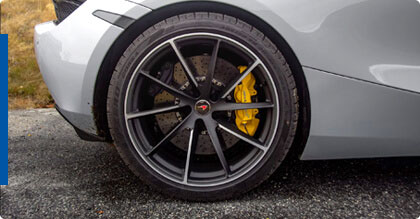
A tyre's speed index or rating describes the maximum speed the tyre is legally approved to travel at. What this means is that the tyre is safe to handle the speed of the car it's fitted on.
A tyre’s certified speed rating is given a letter from A to Z, ranging from 5km/h (3mph) to above 300 km/h (186 mph). For example, a tyre marked with a 'Y' speed rating, indicates it can be safely operated at a maximum speed of 300kph. The higher a tyre's speed rating, the better control and handling you’ll have at higher speeds. An important thing to note is that certain vehicles will require that a tyre with a sufficient speed rating is fitted to them, to ensure the tyre can safely cope with the stresses the vehicle can put through the tyre.
Finding the speed symbol on your tyre is easy - it's usually placed right after the size information, such as the 'V' in the following example '205/55R16 91V'. Look for yours and see what top speed the symbol correlates to in our handy guide.
To understand more about the sidewall markings on your tyre, visit our tyre information guide.
| SPEED SYMBOL | SPEED (KM/H) |
|---|---|
| E | 70 |
| F | 80 |
| G | 90 |
| J | 100 |
| K | 110 |
| L | 120 |
| M | 130 |
| N | 140 |
| P | 150 |
| Q | 160 |
| R | 170 |
| S | 180 |
| T | 190 |
| U | 200 |
| H | 210 |
| V | 240 |
| W | 270 |
| Y | 300 |
| Z & ZR | 240 + |
The load rating, or load index, is a number that tells you what the heaviest load is that your vehicle’s tyres can manage at their maximum speed. These ratings are extremely important to operate within, as an overloaded runs the risk of a possible blowout. The load rating given applies to a single properly inflated tyre - so if you combine the load rating values on your vehicle's full set of tyres, you can calculate the maximum weight your vehicle and any cargo can total.
The load rating is found on the sidewall of all tyres and is represented by a number ranging from 0 to 279. The higher the load rating number, the stronger the tyre. Tyres with a higher load rating can take a greater amount of air pressure, which means they can also carry heavier loads. Take note - the maximum weight that the load rating refers to is in kilograms.
Look for the tyre load symbol on your tyre - such as the '91' in the following example '205/55R16 91V' - and see what maximum load the symbol correlates to in our handy guide.
To understand more about the sidewall markings on your tyre, visit our tyre information guide.

| LOAD INDEX | KG PER TYRE |
|---|---|
| 62 | 265 |
| 63 | 272 |
| 64 | 280 |
| 65 | 290 |
| 66 | 300 |
| 67 | 307 |
| 68 | 315 |
| 69 | 325 |
| 70 | 335 |
| 71 | 345 |
| 72 | 355 |
| 73 | 365 |
| 74 | 375 |
| 75 | 387 |
| 76 | 400 |
| 77 | 412 |
| 78 | 425 |
| 79 | 437 |
| 80 | 450 |
| 81 | 462 |
| 82 | 475 |
| 83 | 487 |
| LOAD INDEX | KG PER TYRE |
|---|---|
| 84 | 500 |
| 85 | 515 |
| 86 | 530 |
| 87 | 545 |
| 88 | 560 |
| 89 | 580 |
| 90 | 600 |
| 91 | 615 |
| 92 | 630 |
| 93 | 650 |
| 94 | 670 |
| 95 | 690 |
| 96 | 710 |
| 97 | 730 |
| 98 | 750 |
| 99 | 775 |
| 100 | 800 |
| 101 | 825 |
| 102 | 850 |
| 103 | 875 |
| 104 | 900 |
| 105 | 925 |
| LOAD INDEX | KG PER TYRE |
|---|---|
| 106 | 950 |
| 107 | 975 |
| 108 | 1000 |
| 109 | 1030 |
| 110 | 1060 |
| 111 | 1090 |
| 112 | 1120 |
| 113 | 1150 |
| 114 | 1180 |
| 115 | 1215 |
| 116 | 1250 |
| 117 | 1285 |
| 118 | 1320 |
| 119 | 1360 |
| 120 | 1400 |
| 121 | 1450 |
| 122 | 1500 |
| 123 | 1550 |
| 124 | 1600 |
| 125 | 1650 |
| 126 | 1700 |
Not sure how to tell the size of your tyre?